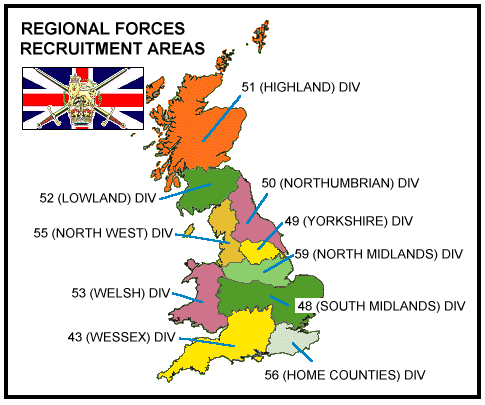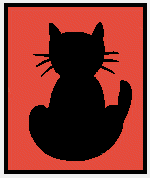|

British Army:
2300AD
United Kingdom
Defence Forces
Introduction
The UKDF is mainly composed of TAVR
forces but with some regular units included. It is split
into manoeuvre and regional forces depending on the level
of equipment, mobility and training priorities. With the
escalation of the Kafer War a major re-working of these
forces has taken place. The Manouvre Forces have been
revitalised with more modern equipment cast off by the
regular army and taken on an increased role in fulfilling
Britain's on Earth commitments. Several battalions have
been mobilised to take on garrison roles.
The Regional Forces have been heavily
re-organised, new battalions raised and regular
battalions (including several newly returned from the
French Arm) have been formally integrated into the
structure. The former 5 Infantry Divisions each of 3
brigades have been converted into 10 French style 'flat'
divisions this has freed up many extra staff officers
required for the front as well as additional training
funding for the battalions.
The most noticeable change is the
numbering change of the divisions and brigades to bring
them into line with the regular Army and leaving only the
Light Division and Airborne forces out of this sequence.
In times of war the UKDF would come
directly under the command of the Joint British Isles
Defence Command (JBID). JBID is a unified command system
integrating the air, sea and land forces of Britain and
Ireland.
Index
- Manoeuvre
Forces
- 32 (Guards) Light Brigade
- 1st
Airborne Brigade
- 4th
Airborne Brigade
- 17th(SE) Mechanised Brigade
- 18th (CW) Mechanised Brigade
- 26th (Recce) Mechanised Brigade
- 19th Mechanised Division
- 20th Mechanised Division
- Regional
Forces
- 43rd
(Wessex) Division
- 48th (South Midlands) Division
- 49th (Yorkshire) Division
- 50th (Northumbrian) Division
- 51st (Highland) Division
- 52nd
(Lowland) Division
- 53rd
(Welsh) Division
- 55th (North West) Division
- 56th (Home Counties) Division
- 59th (South Midlands) Division
Manoeuvre
Forces
Independent Brigades
The 6 independent brigades provide a
resource either for UKDF or for deployment with I
(British) Corps overseas.
32
(Guards) Light Brigade
32 Bde has primarily been a home for
the Household Division on ceremonial duties in the
capital, Windsor and Isle of Wight. These units were
previously organised as GD battalions and would undertake
light infantry training when not on ceremonial duties.
However in the light of the Kafer War this unit has been
re-equipping as a Light Brigade whilst small detachments
continue their public role.
- Household Cavalry Mounted Regiment
(HCMR)
- 2nd Battalion, The Grenadier
Guards (2 GREN GDS)
- 1st Battalion, The Welsh Guards (1
WG)
- 1st Battalion, The Wellon
Guards (1 WELLON GDS)
- 55 (King's Troop) Light Regiment,
Royal Horse Artillery (55 RHA)
1st Airborne
Brigade
The cutting edge of the TA, 1 Abn Bde
is designed to act as the second wave of any intervention
force. However it has been most noticeable for providing
BCR for the regular Parachute battalions in the French
Arm. It has a very high level of readiness and may well
be mobilised for action.
- 10th Battalion (V), The Parachute
Regiment (10 PARA)
- 12th Battalion (V), The Parachute
Regiment (12 PARA)
- 15th Battalion (V), The Parachute
Regiment (15 PARA)
- 101 Parachute Regiment (V), Royal
Artillery (101 RA)
- 109 Parachute Squadron (V), Royal
Engineers
4th Airborne
Brigade
4 Abn Bde, although drawn from line
infantry regiments, is very similar to 1 Abn
Bde and has also sent many volunteers to RGJ units in the
French Arm. The influx of recently returned soldiers mean
this unit has perhaps the best experience of fighting
Kafers in the British reserve forces.
- 10th Battalion (V), The Royal
Green Jackets (10 RGJ)
- 11th Battalion (V), The Royal
Green Jackets (11 RGJ)
- 4th Battalion (V), The Royal Irish
Rangers (4 RIR)
- 102 Light Regiment (V), Royal
Artillery (102 RA)
- 110 Independent Squadron (V),
Royal Engineers
17th
(SE) Mechanised Brigade
17 Mech Bde is the only UKDF heavy
armoured brigade, equipped with Churchill, Cavalier and
Picton AFV's. It packs a major punch and is designed to
reinforce 1st or 2nd Armoured Divisions in time of war.
Recently it has been training heavily with 1 Armd Div
since the deployment of 1 (Guards) Armd Bde to the French
Arm.
- The Queen’s Own Oxfordshire
Hussars (QO OX H)
- The 1st City of London Yeomanry
(Sharpshooters) (1 CLY)
- 8th Battalion (V), The Queen's
Regiment (8 QUEENS)
- 12th (Royal) Battalion (V), The
Royal Regiment of Fusiliers (The London Regiment)
(12 RRF)
- 115 Medium Regiment (V), Royal
Artillery (115 RA)
18th (Combat Walker) Mechanised Brigade
18 CW Mech Bde is composed of four
combat walker equipped battalions, each is planned to be
equipped with 200 Walkers. However with the exception of
12 RGJ these units have only just been re-roled from
their previous tasks as Divisional Recce and are in the
training process and have not received their full
complement of CW. When operational 18 Mech Bde will
provide CW support for any unit within UKDF that requires
it. It will not fight en-masse but provide vital support
in urban combat at company strength.
- The Border Reivers Yeomanry
(Mounted Rifles) (BRY)
- The Northumbrian Yeomanry
(Hussars) (NY)
- The King’s Own Lincolnshire
Yeomanry (KOLY)
- 12th Battalion (V), The Royal
Green Jackets (12 RGJ)
26th
(Recce) Mechanised Brigade
26 Recce Mech Bde is a new formation,
created by grouping together divisional recce units from
the old Infantry Divisions. The unit has both recce AFV
and 'new', hand-me-down Cavalier HBT. This unit have
begun training both as corps level recce, but mainly as
an independent manoeuvre group. It is a poorly kept
secret that in case of a Kafer Invasion of the UK this
brigade will provide immediate reaction forces and attack
the planethead regardless of casualties.
- The 1st Royal Welsh Yeomanry (The
Ancient British) (1 RWY)
- The Royal Anglian Yeomanry (R
ANGLIAN Y)
- The Staffordshire Yeomanry (Black
Country Lancers) (STAFFS Y)

19th Mechanised
Division
The Mech Divs are to be the main mobile
UK defence assets in conjunction with any regular
Armoured forces that remain on the British Isles. Now
equipped with fairly modern Cavalier/Riflemen the Divs
have a similar organisation to Armoured Divisions.
Increasingly the Divisions have been training in more
warlike Battle Groups. The recently renamed 19 Mech Div
is drawn from the south of England and Wales.
- Divisional Manoeuvre Groups
-
- 19th (Welsh) Mechanised Brigade
-
- The 2nd Royal Welsh Yeomanry
(Border Rifles) (2 RWY)
- 5th Battalion (V), The Royal Welch
Fusiliers (5 RWF)
- 7th Battalion (V), The Royal
Regiment of Wales (7 RRW)
-
- 20th (SW) Mechanised Brigade
-
- The Royal Wessex Yeomanry (R WX Y)
- 3rd Battalion (V), The Devon &
Dorset Regiment (3 D&D)
- 6th (Berkshire & Wiltshire)
Battalion (V), The Royal Wessex Regiment (6 R
WESSEX)
-
- 21st (City of London)
Mechanised Brigade
-
- The 2nd City of London Yeomanry
(Devil's Own) (2 CLY)
- 7th Battalions (V), The Queen's
Regiment (7 QUEENS)
- 1st Battalion (V), The London
Scottish (The London Regiment) (1 L SCOTS)
-
- Divisional Recce Group
-
- The Royal Mercian Yeomanry (RMY)
-
- Divisional Artillery Group
-
- 107 Heavy Regiment (V), Royal
Artillery (107 RA)
- 103 Medium Regiment (V), Royal
Artillery (103 RA)
- 113 Air Defence Regiment (V),
Royal Artillery (113 RA)
-
- Divisional Command Group
-
- 19 Mechanised Command Regiment
- 19 Mechanised Regiment (V), Royal
Engineers (19 MECH RE)

20th
Mechanised Division
20 Mech Div is the Scotland and north
England based equivalent of 19 Mech Div.
- Divisional Manoeuvre Groups
-
- 22nd (Scottish) Mechanised
Brigade
-
- The Royal Scottish Yeomanry (R
SCOTS Y)
- 5th Battalion (V), The Royal Scots
(5 RS)
- 6th Battalion (V), The Black Watch
(6 BW)
-
- 23rd (NE) Mechanised Brigade
-
- The Yorkshire Light Horse (North
Riding) (YLH)
- 10th (Durham) Battalion (V), The
Light Infantry (10 LI)
- 11th (Tyneside) Battalion (V), The
Royal Regiment of Fusiliers (11 RRF)
-
- 24th (NW) Mechanised Brigade
-
- The Duke of Lancaster’s Own
Yeomanry (Dragoon Militia) (DLY)
- 7th Battalion (V), The Queen's
Lancashire Regiment (7 QLR)
- 5th Battalion (V), The King's Own
Royal Border Regiment (5 KORBR)
-
- Divisional Recce Group
-
- The Loyal Manchester Yeomanry (Red
Devils) (LMY)
-
- Divisional Artillery Group
-
- 119 Heavy Regiment (V), Royal
Artillery (119 RA)
- 110 Medium Regiment (V), Royal
Artillery (110 RA)
- 106 Air Defence Regiment (V),
Royal Artillery (106 RA)
-
- Divisional Command Group
-
- 20 Mechanised Command Regiment
- 20 Mechanised Regiment (V), Royal
Engineers (20 MECH RE)

Regional
Forces
Regional forces are composed of
infantry, artillery and engineer units. Most are
reservists but each division has at least one regular
battalion. Many of these regular battalions are newly
returned from the Kafer War and whilst recovering are
also passing on their experience to the TAVR battalions.
The regular battalions are now re-organising to Light
Role, whilst one TA battalion is a Close Recce unit (most
are newly raised battalions and still training) and the
remainder GS battalions. Support is provided by
artillery, engineer and command and support regiments.
Currently the divisions have been most
useful in providing individual volunteers for service on
the French Arm. However in case of invasion they would
provide vital service holding static positions and
undertaking warfare in forests and urban areas. The units
are all lightly equipped and with soft-skinned transport.
The new divisions have taken on ancient historic
identities, however the geographical names are not always
completely accurate.


43rd
(Wessex) Division
- 4th Battalion, The Royal Green
Jackets (4 RGJ) (regular)
- 1st Battalion, The Isle of Wight
Rifles (Royal Wessex)(V) (1 IoW R) (close
recce)
- 1st (Royal) Battalion, The Rifle
Volunteers (Royal Wessex) (1 R Vols)
2nd Battalion, The Rifle Volunteers (Royal
Wessex) (2 R Vols)
- 5th (Gloucestershire) Battalion
(V), The Royal Wessex Regiment (5 R WESSEX)
- 4th Battalion (V), The Devon &
Dorset Regiment (4 D&D)
- 13th (Somerset and Cornwall)
Battalion (V), The Light Infantry (13 LI)
-
- 122 Field Regiment (V), Royal
Artillery (122 RA)
- 43 General Regiment (V), Royal
Engineers (43 RE)
- 43 Command and Support Regiment
48th (South Midlands) Division
- 3rd Battalion, The Queen's
Lancashire Regiment (3 QLR) (regular)
- 14th (Shropshire and
Herefordshire) Battalion (V), The Light Infantry*
(14 LI) (close recce)
- 7th Battalion (V), The Royal
Anglian Regiment (7 R ANGLIAN)
- 9th Battalion (V), The Royal
Anglian Regiment (9 R ANGLIAN)
- 10th (Warwickshire) Battalion (V),
The Royal Regiment of Fusiliers (10 RRF)
- 13th Battalion (V), The Royal
Regiment of Fusiliers (13 RRF)
- 14th Battalion (V), The Royal
Regiment of Fusiliers (14 RRF)
-
- 117 Field Regiment (V), Royal
Artillery (117 RA)
- 48 General Regiment (V), Royal
Engineers (48 RE)
- 48 Command and Support Regiment
49th
(Yorkshire) Division
- 1st Battalion, The York and
Lancaster Regiment (1 YLR) (regular)
- 1st Battalion, The Leeds Rifles
(V) (1 LEEDS R)* (close recce)
- 9th (West Yorkshire) Battalion
(V), The Yorkshire Regiment (9 YORKS)
- 11th (Duke of Wellington's)
Battalion (V), The Yorkshire Regiment (11 YORKS)
- 12th (King's Own Yorkshire)
Battalion (V), The Light Infantry (12 LI)
- 3rd (Hallamshire) Battalion (V),
The York and Lancaster Regiment (3 YLR)
- 4th Battalion (V), The
Worcestershire and Sherwood Foresters Regiment (4
WFR)
-
- 129 Field Regiment (V), Royal
Artillery (129 RA)
- 49 General Regiment (V), Royal
Engineers (49 RE)
- 49 Command and Support Regiment
50th
(Northumbrian) Division

- 1st Battalion, The Coldstream
Guards (1 COLD GDS) (regular)
- 1st Battalion, The Royal
Northumbrian Rangers (V) (1 RNR)* (close
recce)
- 9th (Northumbrian) Battalion (V),
The Royal Regiment of Fusiliers (9 RRF)
- 15th (City of Newcastle) Battalion
(V), The Royal Regiment of Fusiliers (15 RRF)*
- 10th (Green Howards) Battalion
(V), The Yorkshire Regiment (10 YORKS)
- 12th (East Yorkshire) Battalion
(V), The Yorkshire Regiment (12 YORKS)
- 11th (Durham) Battalion (V), The
Light Infantry (11 LI)
-
- 104 Field Regiment (V), Royal
Artillery (104 RA)
- 50 General Regiment (V), Royal
Engineers (50 RE)
- 50 Command and Support Regiment
51st
(Highland) Division

- 2nd (2/68th Durham) Battalion, The Light Infantry
(2 LI) (regular)
1st Battalion, The Queen's Own (Seaforth) Highlanders (1
QOH) (regular)
1st Battalion, The Lovat Scouts (V) (1
LS)* (close recce)
5th Battalion (V), The Black Watch (5 BW)
3rd Battalion (V), The Queen's Own (Seaforth) Highlanders
(3 QO HLDRS)
3rd Battalion (V), The Cameron Highlanders (3 C HLDRS)
3rd Battalion (V), The Gordon Highlanders (3 GORDONS)
4th Battalion (V), The Gordon Highlanders (4 GORDONS)
3rd Battalion (V), The Argyll and Sutherland Highlanders
(3 A&SH)
- 127 Field Regiment (V), Royal Artillery (127 RA)
- 51 General Regiment (V), Royal Engineers (51 RE)
- 51 Command and Support Regiment
52nd
(Lowland) Division
- 1st Battalion, The Cameronians (1
CAMS) (regular)
- 3rd Battalion (V), The Scottish
Rifles (3 SR) (close recce)
- 6th Battalion (V), The Royal Scots
(6 RS)
- 3rd Battalion (V), The Royal Scots
Fusiliers (3 RSF)
- 3rd Battalion (V), The Highland
Light Infantry (3 HLI)
- 3rd Battalion (V), The King's Own
Scottish Borderers (3 KOSB)
- 3rd Battalion (V), The Cameronians
(3 CAMS)
-
- 108 Field Regiment (V), Royal
Artillery (108 RA)
- 52 General Regiment (V), Royal
Engineers (52 RE)
- 52 Command and Support Regiment
53rd
(Welsh) Division
The Welsh Division is the smallest
division but includes two regular battalions.
Headquartered at Brecon it provides much support to the
School of Infantry there.
- 2nd (41st Welch) Battalion, The
Royal Regiment of Wales (2 RRW) (regular)
- 3rd Battalion, The Royal Green
Jackets (3 RGJ) (regular)
- 6th Battalion (V), The Royal Welch
Fusiliers (6 RWF) (close recce)
- 8th Battalions (V), The Royal
Regiment of Wales (8 RRW)
- 9th Battalions (V), The Royal
Regiment of Wales (9 RRW)
- 1st Battalion, The North Wales
Rifle Volunteers (1 NWRV)
-
- 125 Field Regiment (V), Royal
Artillery (125 RA)
- 53 General Regiment (V), Royal
Engineers (53 RE)
- 53 Command and Support Regiment
55th
(North West) Division
- 1st Battalion, The Royal Regiment
of Fusiliers (1 RRF) (regular)
- 10th Battalion (V), The Queen's
Lancashire Regiment (10 QLR)* (close recce)
- 5th (Liverpool) Battalion (V), The
King's Regiment (5 KINGS)
- 6th (Manchester) Battalion (V),
The King's Regiment (6 KINGS)
- 6th Battalion (V), The King's Own
Royal Border Regiment (6 KORBR)
- 8th Battalion (V), The Queen's
Lancashire Regiment (8 QLR)
- 9th Battalion (V), The Queen's
Lancashire Regiment (9 QLR)
-
- 109 Field Regiment (V), Royal
Artillery (109 RA)
- 55 General Regiment (V), Royal
Engineers (55 RE)
- 55 Command and Support Regiment
56th
(Home Counties) Division

- 5th Battalion, The Royal Green
Jackets (5 RGJ) (regular)
- 1st Battalion, The Artists Rifles
(The London Regiment)(V) (1 ARTISTS)* (close
recce)
- 9th Battalion (V), The Queen's
Regiment (The London Regiment) (9 QUEENS)
- 1st Battalion (V), The London
Irish Rifles (The London Regiment) (1 L IR)
- 1st Battalion (V), The London
South Africans (The London Regiment) (1 L SA)
- 5th (Home Counties) Battalion (V),
The Queen's Regiment (5 QUEENS)
- 6th (Kent & Cinque Ports)
Battalion (V), The Queen's Regiment (6 QUEENS)
-
- 116 Field Regiment (V), Royal
Artillery (116 RA)
- 56 General Regiment (V), Royal
Engineers (56 RE)
- 56 Command and Support Regiment
59th (North Midlands) Division
- 1st (Liverpool) Battalion, The
King's Regiment (1 KINGS) (regular)
- 3rd Battalion (V), The Cheshire
Regiment (3 CHESHIRE) (close recce)
- 4th Battalion (V), The Cheshire
Regiment (4 CHESHIRE)
- 3rd (North Staffs) Battalion (V),
The Staffordshire Regiment (3 STAFFORD)
- 4th (South Staffs) Battalion (V),
The Staffordshire Regiment (4 STAFFORD)
- 3rd Battalion (V), The
Worcestershire & Sherwood Foresters Regiment
(3 WFR)
- 8th Battalion (V), The Royal
Anglian Regiment (8 R ANGLIAN)
-
- 130 Field Regiment (V), Royal
Artillery (130 RA)
- 59 General Regiment (V), Royal
Engineers (59 RE)
- 59 Command and Support Regiment

Copyright 2009, D Hebditch
|





